24.0 Introduction
24.0.1 Why Should I Take this Module?
Good protocols can have bad uses. Sometimes the protocols that we use daily can be turned against us. There are many different protocols that are used in the day-to-day operations of a network. This module will explain how these protocols interact with and impact network security monitoring.
24.0.2 What Will I Learn in this Module?
Module Title: Technologies and Protocols
Module Objective: Explain how security technologies affect security monitoring.
| Topic | Topic Objective |
|---|---|
| Monitoring Common Protocols | Explain the behavior of common network protocols in the context of security monitoring. |
| Security Technologies | Explain how security technologies affect the ability to monitor common network protocols. |
24.1 Monitoring Common Protocols
24.1.1 Syslog and NTP
Various protocols that commonly appear on networks have features that make them of special interest in security monitoring. For example, syslog and Network Time Protocol (NTP) are essential to the work of the cybersecurity analyst.
The syslog standard is used for logging event messages from network devices and endpoints, as shown in the figure. The standard allows for a system-neutral means of transmitting, storing, and analyzing messages. Many types of devices from many different vendors can use syslog to send log entries to central servers that run a syslog daemon. This centralization of log collection helps to make security monitoring practical. Servers that run syslog typically listen on UDP port 514.
Because syslog is so important to security monitoring, syslog servers may be a target for threat actors. Some exploits, such as those involving data exfiltration, can take a long time to complete due to the very slow ways in which data is secretly stolen from the network. Some attackers may try to hide the fact that exfiltration is occurring. They attack syslog servers that contain the information that could lead to detection of the exploit. Hackers may attempt to block the transfer of data from syslog clients to servers, tamper with or destroy log data, or tamper with the software that creates and transmits log messages. The next generation (ng) syslog implementation, known as syslog-ng, offers enhancements that can help prevent some of the exploits that target syslog.
Search the internet for more information about syslog-ng..
Syslog

24.1.2 NTP
Syslog messages are usually timestamped. This allows messages from different sources to be organized by time to provide a view of network communication processes. Because the messages can come from many devices, it is important that the devices share a consistent timeclock. One way that this can be achieved is for the devices to use Network Time Protocol (NTP). NTP uses a hierarchy of authoritative time sources to share time information between devices on the network, as shown in the figure. In this way, device messages that share consistent time information can be submitted to the syslog server. NTP operates on UDP port 123.
Because events that are connected to an exploit can leave traces across every network device on their path to the target system, timestamps are essential for detection. Threat actors may attempt to attack the NTP infrastructure in order to corrupt time information used to correlate logged network events. This can serve to obfuscate traces of ongoing exploits. In addition, threat actors have been known to use NTP systems to direct DDoS attacks through vulnerabilities in client or server software. While these attacks do not necessarily result in corrupted security monitoring data, they can disrupt network availability.
NTP

24.1.3 DNS
Domain Name Service (DNS) is used by millions of people daily. Because of this, many organizations have less stringent policies in place to protect against DNS-based threats than they have to protect against other types of exploits. Attackers have recognized this and commonly encapsulate different network protocols within DNS to evade security devices. DNS is now used by many types of malware. Some varieties of malware use DNS to communicate with command-and-control (CnC) servers and to exfiltrate data in traffic disguised as normal DNS queries. Various types of encoding, such as Base64, 8-bit binary, and Hex can be used to camouflage the data and evade basic data loss prevention (DLP) measures.
For example, malware could encode stolen data as the subdomain portion of a DNS lookup for a domain where the nameserver is under control of an attacker. A DNS lookup for ‘long-string-of-exfiltrated-data.example.com’ would be forwarded to the nameserver of example.com, which would record ‘long-string-of-exfiltrated-data’ and reply back to the malware with a coded response. This use of the DNS subdomain is shown in the figure. The exfiltrated data is the encoded text shown in the box. The threat actor collects this encoded data, decodes and combines it, and now has access to an entire data file, such as a username/password database.
It is likely that the subdomain part of such requests would be much longer than usual requests. Cyber analysts can use the distribution of the lengths of subdomains within DNS requests to construct a mathematical model that describes normality. They can then use this to compare their observations and identify an abuse of the DNS query process. For example, it would not be normal to see a host on your network sending a query to aW4gcGxhY2UgdG8gcHJvdGVjdC.example.com.
DNS queries for randomly generated domain names, or extremely long random-appearing subdomains, should be considered suspicious, especially if their occurrence spikes dramatically on the network. DNS proxy logs can be analyzed to detect these conditions. Alternatively, services such as the Cisco Umbrella passive DNS service can be used to block requests to suspected CnC and exploit domains.
DNS Exfiltration
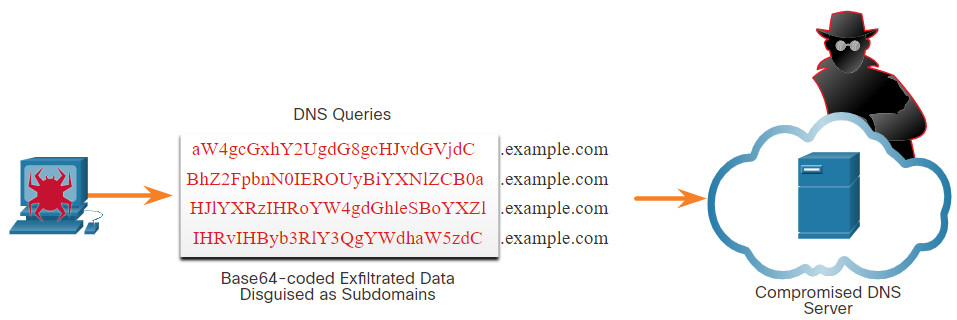
24.1.4 HTTP and HTTPS
Hypertext Transfer Protocol (HTTP) is the backbone protocol of the World Wide Web. However, all information carried in HTTP is transmitted in plaintext from the source computer to the destination on the internet. HTTP does not protect data from alteration or interception by malicious parties, which is a serious threat to privacy, identity, and information security. All browsing activity should be considered to be at risk.
A common exploit of HTTP is called iFrame (inline frame) injection. Most web-based threats consist of malware scripts that have been planted on webservers. These webservers then direct browsers to infected servers by loading iframes. In iFrame injection, a threat actor compromises a webserver and plants malicious code which creates an invisible iFrame on a commonly visited webpage. When the iFrame loads, malware is downloaded, frequently from a different URL than the webpage that contains the iFrame code. Network security services, such as Cisco Web Reputation filtering, can detect when a website attempts to send content from an untrusted website to the host, even when sent from an iFrame, as shown in the figure.
HTTP iFrame Injection Exploit
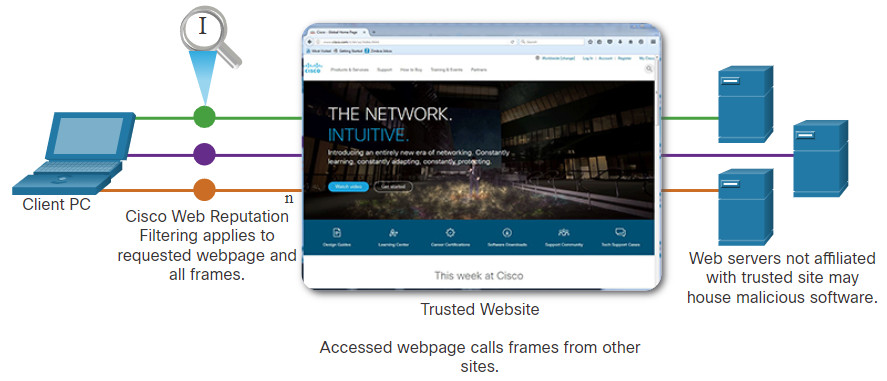
To address the alteration or interception of confidential data, many commercial organizations have adopted HTTPS or implemented HTTPS-only policies to protect visitors to their websites and services.
HTTPS adds a layer of encryption to the HTTP protocol by using secure socket layer (SSL), as shown in the figure. This makes the HTTP data unreadable as it leaves the source computer until it reaches the server. Note that HTTPS is not a mechanism for web server security. It only secures HTTP protocol traffic while it is in transit.
HTTPS Protocol Diagram

Unfortunately, the encrypted HTTPS traffic complicates network security monitoring. Some security devices include SSL decryption and inspection; however, this can present processing and privacy issues. In addition, HTTPS adds complexity to packet captures due to the additional messaging involved in establishing the encrypted connection. This process is summarized in the figure and represents additional overhead on top of HTTP.
HTTPS Transactions
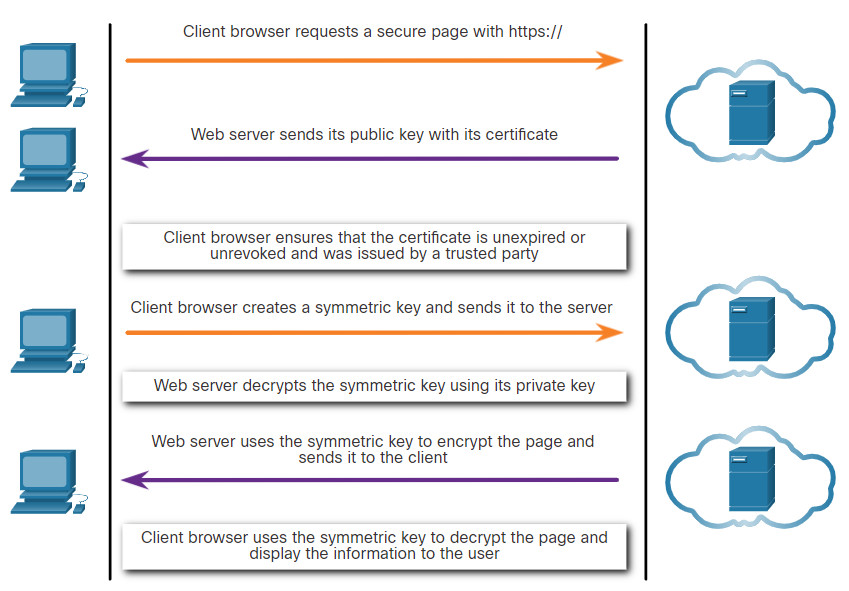
24.1.5 Email Protocols
Email protocols such as SMTP, POP3, and IMAP can be used by threat actors to spread malware, exfiltrate data, or provide channels to malware CnC servers, as shown in the figure.
SMTP sends data from a host to a mail server and between mail servers. Like DNS and HTTP, it is a common protocol to see leaving the network. Because there is so much SMTP traffic, it is not always monitored. However, SMTP has been used in the past by malware to exfiltrate data from the network. In the 2014 hack of Sony Pictures, one of the exploits used SMTP to exfiltrate user details from compromised hosts to CnC servers. This information may have been used to help develop exploits of secured resources within the Sony Pictures network. Security monitoring could reveal this type of traffic based on features of the email message.
IMAP and POP3 are used to download email messages from a mail server to the host computer. For this reason, they are the application protocols that are responsible for bringing malware to the host. Security monitoring can identify when a malware attachment entered the network and which host it first infected. Retrospective analysis can then track the behavior of the malware from that point forward. In this way, the malware behavior can better be understood and the threat identified. Security monitoring tools may also allow recovery of infected file attachments for submission to malware sandboxes for analysis.
Email Protocol Threats
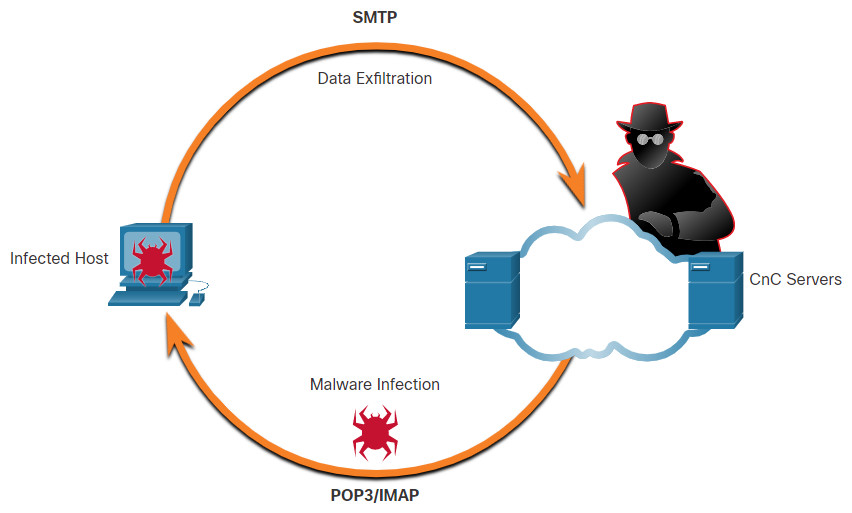
24.1.6 ICMP
ICMP has many legitimate uses, however ICMP functionality has also been used to craft a number of types of exploits. ICMP can be used to identify hosts on a network, the structure of a network, and determine the operating systems at use on the network. It can also be used as a vehicle for various types of DoS attacks.
ICMP can also be used for data exfiltration. Because of the concern that ICMP can be used to surveil or deny service from outside of the network, ICMP traffic from inside the network is sometimes overlooked. However, some varieties of malware use crafted ICMP packets to transfer files from infected hosts to threat actors using this method, which is known as ICMP tunneling.
Search the internet for a detailed explanation of the well-known LOKI exploit.
Note: This site might be blocked by your institution’s firewall.
A number of tools exist for crafting tunnels. Search the internet for Ping Tunnel to explore one such tool.
24.2 Security Technologies
24.2.1 ACLs
Many technologies and protocols can have impacts on security monitoring. Access Control Lists (ACLs) are among these technologies. ACLs can give a false sense of security if they are overly relied upon. ACLs, and packet filtering in general, are technologies that contribute to an evolving set of network security protections.
The figure illustrates the use of ACLs to permit only specific types of Internet Control Message Protocol (ICMP) traffic. The server at 192.168.1.10 is part of the inside network and is allowed to send ping requests to the outside host at 209.165.201.3. The outside host’s return ICMP traffic is allowed if it is an ICMP reply, source quench (tells the source to reduce the pace of traffic), or any ICMP unreachable message. All other ICMP traffic types are denied. For example, the outside host cannot initiate a ping request to the inside host. The outbound ACL is allowing ICMP messages that report various problems. This will allow ICMP tunneling and data exfiltration.
Attackers can determine which IP addresses, protocols, and ports are allowed by ACLs. This can be done either by port scanning, penetration testing, or through other forms of reconnaissance. Attackers can craft packets that use spoofed source IP addresses. Applications can establish connections on arbitrary ports. Other features of protocol traffic can also be manipulated, such as the established flag in TCP segments. Rules cannot be anticipated and configured for all emerging packet manipulation techniques.
In order to detect and react to packet manipulation, more sophisticated behavior and context-based measures need to be taken. Cisco Next Generation firewalls, Advanced Malware Protection (AMP), and email and web content appliances are able to address the shortcomings of rule-based security measures.
Mitigating ICMP Abuse
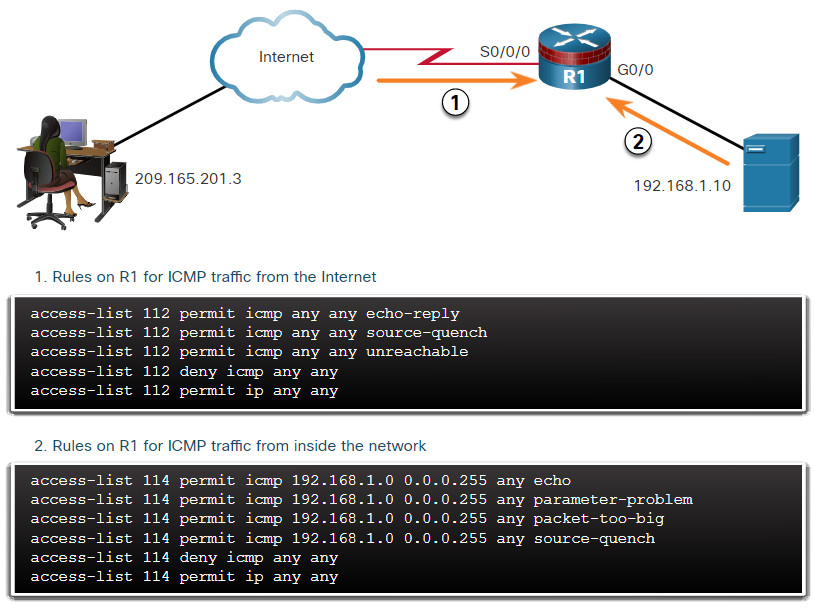
24.2.2 NAT and PAT
Network Address Translation (NAT) and Port Address Translation (PAT) can complicate security monitoring. Multiple IP addresses are mapped to one or more public addresses that are visible on the internet, hiding the individual IP addresses that are inside the network (inside addresses).
The figure illustrates the relationship between internal and external addresses that are used as source addresses (SA) and destination addresses (DA). These internal and external addresses are in a network that is using NAT to communicate with a destination on the internet. If PAT is in effect, and all IP addresses leaving the network use the 209.165.200.226 inside global address for traffic to the internet, it could be difficult to log the specific inside device that is requesting and receiving the traffic when it enters the network.
This problem can be especially relevant with NetFlow data. NetFlow flows are unidirectional and are defined by the addresses and ports that they share. NAT will essentially break a flow that passes a NAT gateway, making flow information beyond that point unavailable. Cisco offers security products that will “stitch” flows together even if the IP addresses have been replaced by NAT.
NetFlow is discussed in more detail later in the module.
Network Address Translation
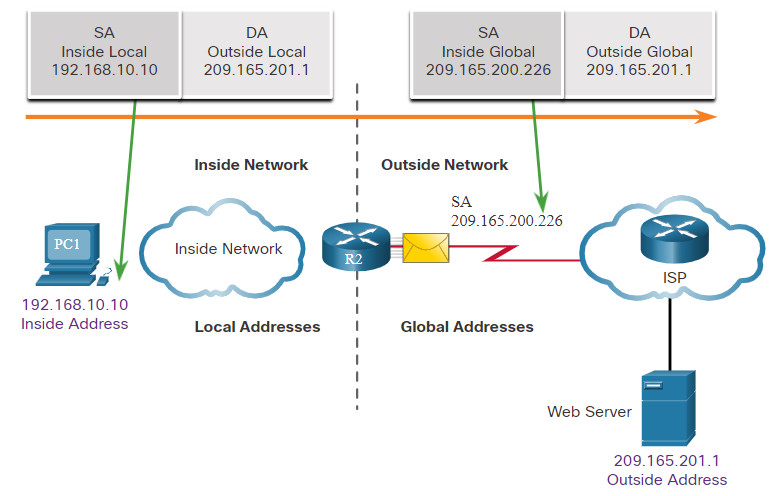
24.2.3 Encryption, Encapsulation, and Tunneling
As mentioned with HTTPS, encryption can present challenges to security monitoring by making packet details unreadable. Encryption is part of VPN technologies. In VPNs, a commonplace protocol like IP, is used to carry encrypted traffic. The encrypted traffic essentially establishes a virtual point-to-point connection between networks over public facilities. Encryption makes the traffic unreadable to any other devices but the VPN endpoints.
A similar technology can be used to create a virtual point-to-point connection between an internal host and threat actor devices. Malware can establish an encrypted tunnel that rides on a common and trusted protocol, and use it to exfiltrate data from the network. A similar method of data exfiltration was discussed previously for DNS.
24.2.4 Peer-to-Peer Networking and Tor
In peer-to-peer (P2P) networking, shown in the figure, hosts can operate in both client and server roles. Three types of P2P applications exist: file sharing, processor sharing, and instant messaging. In file sharing P2P, files on a participating machine are shared with members of the P2P network. Examples of this are the once popular Napster and Gnutella. Bitcoin is a P2P operation that involves the sharing of a distributed database, or ledger, that records Bitcoin balances and transactions. BitTorrent is a P2P file sharing network.
Any time that unknown users are provided access to network resources, security is a concern. File-sharing P2P applications should not be allowed on corporate networks. P2P network activity can circumvent firewall protections and is a common vector for the spread of malware. P2P is inherently dynamic. It can operate by connecting to numerous destination IP addresses, and it can also use dynamic port numbering. Shared files are often infected with malware, and threat actors can position their malware on P2P clients for distribution to other users.
Processor sharing P2P networks donate processor cycles to distributed computational tasks. Cancer research, searching for extraterrestrials, and scientific research use donated processor cycles to distribute computational tasks.
Instant messaging (IM) is also considered to be a P2P application. IM has legitimate value within organizations that have geographically distributed project teams. In this case, specialized IM applications are available, such as the Webex Teams platform, which are more secure than IM that uses public servers.
P2P
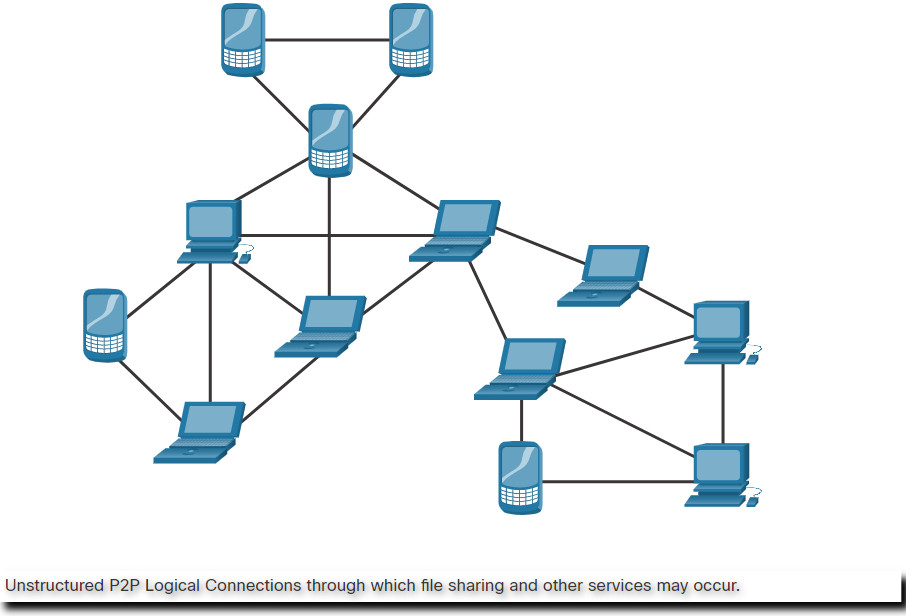
Tor is a software platform and network of P2P hosts that function as internet routers on the Tor network. The Tor network allows users to browse the internet anonymously. Users access the Tor network by using a special browser. When a browsing session is begun, the browser constructs a layered end-to-end path across the Tor server network that is encrypted, as shown in the figure. Each encrypted layer is “peeled away” like the layers of an onion (hence “onion routing”) as the traffic traverses a Tor relay. The layers contain encrypted next-hop information that can only be read by the router that needs to read the information. In this way, no single device knows the entire path to the destination, and routing information is readable only by the device that requires it. Finally, at the end of the Tor path, the traffic reaches its internet destination. When traffic is returned to the source, an encrypted layered path is again constructed.
Tor presents a number of challenges to cybersecurity analysts. First, Tor is widely used by criminal organizations on the “dark net.” In addition, Tor has been used as a communications channel for malware CnC. Because the destination IP address of Tor traffic is obfuscated by encryption, with only the next-hop Tor node known, Tor traffic avoids blacklists that have been configured on security devices.
Tor Operation
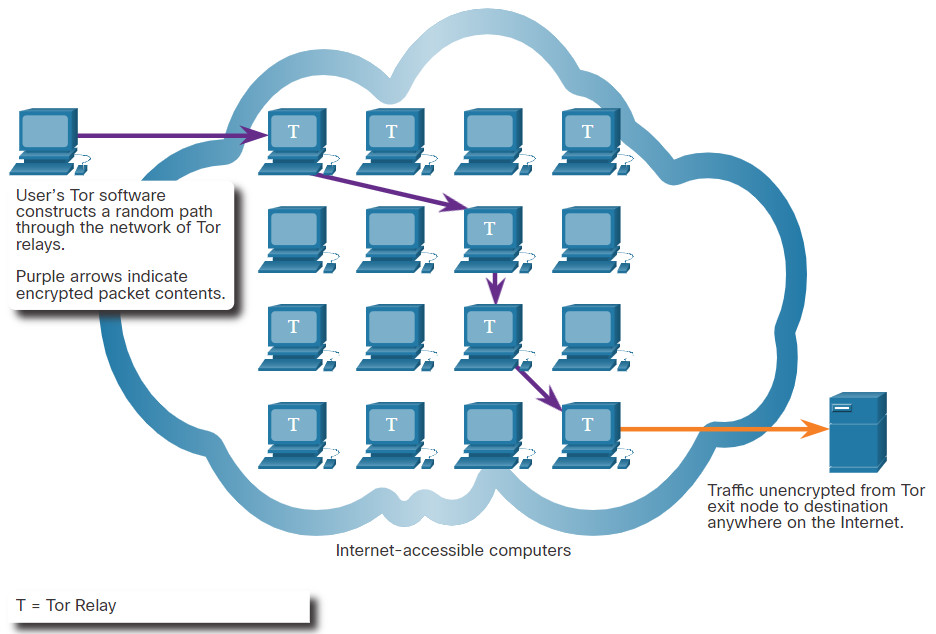
24.2.5 Load Balancing
Load balancing involves the distribution of traffic between devices or network paths to prevent overwhelming network resources with too much traffic. If redundant resources exist, a load balancing algorithm or device will work to distribute traffic between those resources, as shown in the figure.
One way this is done on the internet is through various techniques that use DNS to send traffic to resources that have the same domain name but multiple IP addresses. In some cases, the distribution may be to servers that are distributed geographically. This can result in a single internet transaction being represented by multiple IP addresses on the incoming packets. This may cause suspicious features to appear in packet captures. In addition, some load balancing manager (LBM) devices use probes to test for the performance of different paths and the health of different devices. For example, an LBM may send probes to the different servers that it is load balancing traffic to in order to detect that the servers are operating. This is done to avoid sending traffic to a resource that is not available. These probes can appear to be suspicious traffic if the cybersecurity analyst is not aware that this traffic is part of the operation of the LBM.
Load Balancing with DNS Delegation
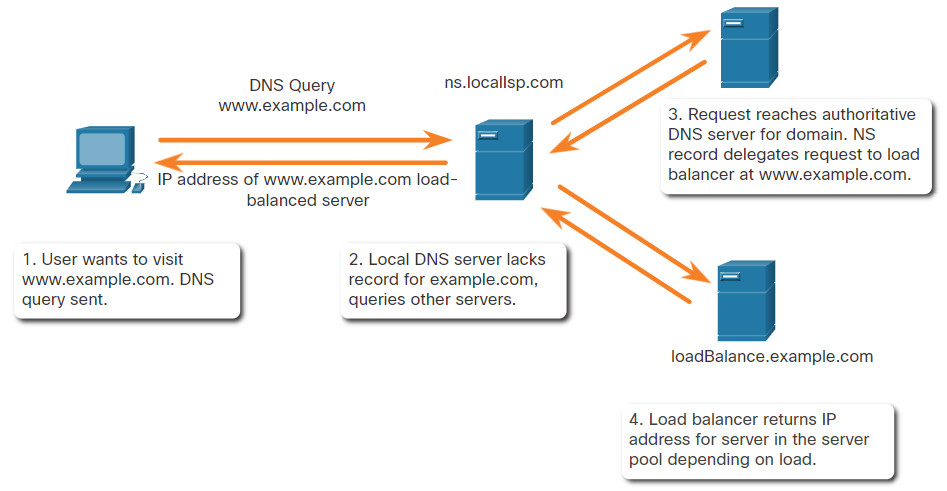
24.3 Technologies and Protocols Summary
24.3.1 What Did I Learn in this Module?
Monitoring Common Protocols
Many types of devices from many different vendors can use syslog to send log entries to central servers that run a syslog daemon. This centralization of log collection helps to make security monitoring practical. Because syslog is so important to security monitoring, syslog servers may be a target for threat actors.. Hackers may attempt to block the transfer of data from syslog clients to servers, tamper with or destroy log data, or tamper with software that creates and transmits log messages. Syslog messages are usually timestamped. Because the messages can come from many devices, it is important that the devices share a consistent timeclock. One way that this can be achieved is for the devices to use Network Time Protocol (NTP). Because events that are connected to an exploit can leave traces across every network device on their path to the target system, timestamps are essential for detection. Threat actors may attempt to attack the NTP infrastructure in order to corrupt time information that is used to correlate logged network events or use NTP systems to direct DDoS attacks through vulnerabilities in client or server software.
Attackers commonly encapsulate different network protocols within DNS to evade security devices. DNS is now used by many types of malware. Some varieties of malware use DNS to communicate with command-and-control (CnC) servers and to exfiltrate data in traffic disguised as normal DNS queries. Various types of encoding can be used to camouflage the data and evade basic data loss prevention (DLP) measures. It is likely that the subdomain part of such queries would be much longer than usual requests.
Hypertext Transfer Protocol (HTTP) is the backbone protocol of the World Wide Web. HTTP does not protect data from alteration or interception by malicious parties, which is a serious threat to privacy, identity, and information security. A common exploit of HTTP is called iFrame (inline frame) injection. A threat actor compromises a webserver and plants malicious code which creates an invisible iFrame on a commonly visited webpage. When the iFrame loads, malware is downloaded. To address the alteration or interception of confidential data, many commercial organizations have adopted HTTPS or implemented HTTPS-only policies to protect visitors to their websites and services. HTTPS adds a layer of encryption to the HTTP protocol by using secure socket layer (SSL), making the HTTP data unreadable as it leaves the source computer until it reaches the server. Unfortunately, the encrypted HTTPS traffic complicates network security monitoring. Some security devices include SSL decryption and inspection; however, this can present processing and privacy issues. In addition, HTTPS adds complexity to packet captures due to the additional messaging involved in establishing the encrypted connection.
Email protocols such as SMTP, POP3, and IMAP can be used by threat actors to spread malware, exfiltrate data, or provide channels to malware CnC servers. SMTP sends data from a host to a mail server and between mail servers. Because there is so much SMTP traffic, it is not always monitored. However, SMTP has been used in the past by malware to exfiltrate data from the network. Security monitoring could reveal this type of traffic based on features of the email message. IMAP and POP3 are used to download email messages from a mail server to the host computer. Security monitoring can identify when a malware email attachment entered the network, and which host it first infected. Retrospective analysis can then track the behavior of the malware from that point forward.
ICMP functionality has been used to craft a number of types of exploits. ICMP can be used to identify hosts on a network, the structure of a network, and determine the operating systems at use on the network. It can also be used as a vehicle for various types of DoS attacks. It can also be used for data exfiltration. Because of the concern that ICMP can be used to surveil or deny service from outside of the network, ICMP traffic from inside the network is sometimes overlooked. However, some varieties of malware use crafted ICMP packets to transfer files from infected hosts to threat actors using this method, which is known as ICMP tunneling.
Security Technologies
ACLs can give a false sense of security if they are overly relied upon. Attackers can determine which IP addresses, protocols, and ports are allowed by ACLs. This can be done either by port scanning or penetration testing, or through other forms of reconnaissance. Attackers can craft packets that use spoofed source IP addresses. Applications can establish connections on arbitrary ports. Other features of protocol traffic can also be manipulated, such as the established flag in TCP segments. Rules cannot be anticipated and configured for all emerging packet manipulation techniques.
Network Address Translation (NAT) and Port Address Translation (PAT) can complicate security monitoring. Multiple IP addresses are mapped to one or more public addresses that are visible on the internet, hiding the individual IP addresses that are inside the network (inside addresses). This problem can be especially relevant with NetFlow data. NetFlow flows are unidirectional and are defined by the addresses and ports that they share. NAT will essentially break a flow that passes a NAT gateway, making flow information beyond that point unavailable.
Encryption can present challenges to security monitoring by making packet details unreadable. Encryption is part of VPN technologies. In VPNs, a commonplace protocol like IP, is used to carry encrypted traffic. The encrypted traffic essentially establishes a virtual point-to-point connection between networks over public facilities. Encryption makes the traffic unreadable to any other devices but the VPN endpoints. A similar technology can be used to create a virtual point-to-point connection between an internal host and threat actor devices. Malware can establish an encrypted tunnel that rides on a common and trusted protocol and use it to exfiltrate data from the network.
In peer-to-peer (P2P) networking, hosts can operate in both client and server roles. Three types of P2P applications exist: file sharing, processor sharing, and instant messaging. In file sharing P2P, files on a participating machine are shared with members of the P2P network. Any time that unknown users are provided access to network resources, security is a concern. File-sharing P2P applications should not be allowed on corporate networks. P2P network activity can circumvent firewall protections and is a common vector for the spread of malware. P2P is inherently dynamic. Shared files are often infected with malware, and threat actors can position their malware on P2P clients for distribution to other users.
Tor is a software platform and network of P2P hosts that function as internet routers on the Tor network. This allows users to browse the internet anonymously. Users access the Tor network by using a special browser. The browser constructs a layered end-to-end path across the Tor server network that is encrypted. Each encrypted layer is “peeled away” like the layers of an onion (hence “onion routing”) as the traffic traverses a Tor relay. The layers contain encrypted next-hop information that can only be read by the router that needs to read the information. When traffic is returned to the source, an encrypted layered path is again constructed. Tor presents a number of challenges to cybersecurity analysts. First, Tor is widely used by criminal organizations on the “dark net.” In addition, Tor has been used as a communications channel for malware CnC. Because the destination IP address of Tor traffic is obfuscated by encryption, with only the next-hop Tor node known, Tor traffic avoids blacklists that have been configured on security devices.
Load balancing involves the distribution of traffic between devices or network paths to prevent overwhelming network resources with too much traffic. One way this is done on the internet is through various techniques that use DNS to send traffic to resources that have the same domain name but multiple IP addresses. This can result in a single internet transaction being represented by multiple IP addresses on the incoming packets, which may cause suspicious features to appear in packet captures. Some load balancing manager (LBM) devices use probes to test for the performance of different paths and the health of different devices. These probes can appear to be suspicious traffic if the cybersecurity analyst is not aware that this traffic is part of the operation of the LBM.
